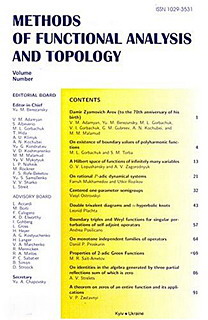Vol. 20 (2014), no. 3
Schatten class operators on the Bergman space over bounded symmetric domain
MFAT 20 (2014), no. 3, 193-212
193-212
Let $\Omega$ be a bounded symmetric domain in $\mathbb{C}^{n}$ with Bergman kernel $K(z, w)$. Let $dV_{\lambda}(z)=K(z, z)\frac{dV(z)}{C_{\lambda}}$, where $C_{\lambda}=\displaystyle\int_{\Omega}K(z, z)^{\lambda}dV(z)$, $\lambda\in\mathbb{R}$, $dV(z)$ is the volume measure of $\Omega$ normalized so that $K(z, 0)=K(0, w)=1$. In this paper we have shown that if the Toeplitz operator $T_{\phi}$ defined on $L_{a}^{2}(\Omega, \frac{dV}{C_{0}})$ belongs to the Schatten $p$-class, $1\leq p<\infty$, then $\widetilde{\phi}\in L^{p}(\Omega, d\eta)$, where $d\eta(z)=K(z, z)\frac{dV(z)}{C_{0}}$ and $\widetilde{\phi}$ is the Berezin transform of $\phi$. Further if $\phi\in L^{p}(\Omega, d\eta_{\lambda})$, then $\widetilde{\phi_{\lambda}}\in L^{p}(\Omega, d\eta_{\lambda})$ and $T_{\phi}^{\lambda}$ belongs to Schatten $p$-class. Here $d\eta_{\lambda}=K(z, z)\frac{dV(z)}{C_{\lambda}}$, the function $\widetilde{\phi_{\lambda}}$ is the Berezin transform of $\phi$ in $L_{a}^{2}(\Omega, dV_{\lambda})$ and $T_{\phi}^{\lambda}$ is the Toeplitz operator defined on $L_{a}^{2}(\Omega, dV_{\lambda})$. We also find conditions on bounded linear operator $C$ defined from $L_{a}^{2}(\Omega, dV_{\lambda})$ into itself such that $C$ belongs to the Schatten $p$-class by comparing it with positive Toeplitz operators defined on $L_{a}^{2}(\Omega, dV_{\lambda})$. Applications of these results are obtained and we also present Schatten class characterization of little Hankel operators defined on $L_{a}^{2}(\Omega, dV_{\lambda})$.
Nonzero capacity sets and dense subspaces in scales of Sobolev spaces
Mykola E. Dudkin, Volodymyr D. Koshmanenko
MFAT 20 (2014), no. 3, 213-218
213-218
We show that for a compact set $K\subset{\mathbb R}^n$ of nonzero $\alpha$-capacity, $C_\alpha(K)>0$, $\alpha\geq 1$, the subspace $\overset{\circ}{W}{^{\alpha,2}}(\Omega)$, $\Omega={\mathbb R}^n\setminus K$ in ${W}{^{\alpha,2}}({\mathbb R}^n)$ is dense in $W^{m,2}({\mathbb R}^n)$, $m\leq\alpha-1$, iff the $m$-capacity of $K$ is zero, $C_{m}(K)=0$.
Direct and inverse spectral problems for block Jacobi type bounded symmetric matrices related to the two dimensional real moment problem
Mykola E. Dudkin, Valentyna I. Kozak
MFAT 20 (2014), no. 3, 219-251
219-251
We generalize the connection between the classical power moment problem and the spectral theory of selfadjoint Jacobi matrices. In this article we propose an analog of Jacobi matrices related to some system of orthonormal polynomials with respect to the measure on the real plane. In our case we obtained two matrices that have a block three-diagonal structure and are symmetric operators acting in the space of $l_2$ type. With this connection we prove the one-to-one correspondence between such measures defined on the real plane and two block three-diagonal Jacobi type symmetric matrices. For the simplicity we investigate in this article only bounded symmetric operators. From the point of view of the two dimensional moment problem this restriction means that the measure in the moment representation (or the measure, connected with orthonormal polynomials) has compact support.
On the a.c. spectrum of the 1D discrete Dirac operator
Sylvain Golénia, Tristan Haugomat
MFAT 20 (2014), no. 3, 252-273
252-273
In this paper, under some integrability condition, we prove that an electrical perturbation of the discrete Dirac operator has purely absolutely continuous spectrum for the one dimensional case. We reduce the problem to a non-self-adjoint Laplacian-like operator by using a spin up/down decomposition and rely on a transfer matrices technique.
On behavior at infinity of solutions of parabolic differential equations in a Banach space
M. L. Gorbachuk, V. I. Gorbachuk
MFAT 20 (2014), no. 3, 274-283
274-283
For a differential equation of the form $y'(t) + Ay(t) = 0, \ t \in (0, \infty)$, where $A$ is the generating operator of a $C_{0}$-semigroup of linear operators on a Banach space $\mathfrak{B}$, we give conditions on the operator $A$, under which this equation is uniformly (uniformly exponentially) stable, that is, every its weak solution defined on the open semiaxis $(0, \infty)$ tends (tends exponentially) to 0 as $t \to \infty$. As distinguished from the previous works dealing only with solutions continuous at 0, in this paper no conditions on the behavior of a solution near 0 are imposed. In the case where the equation is parabolic, there always exist weak solutions which have singularities of any order. The criterions below not only generalize, but make more precise a number of earlier results in this direction.
Hypercyclic composition operators on Hilbert spaces of analytic functions
Z. H. Mozhyrovska, A. V. Zagorodnyuk
MFAT 20 (2014), no. 3, 284-291
284-291
In the paper we consider composition operators on Hilbert spaces of analytic functions of infinitely many variables. In particular, we establish some conditions under which composition operators are hypercyclic and construct some examples of Hilbert spaces of analytic functions which do not admit hypercyclic operators of composition with linear operators.
Comment on 'A uniform boundedness theorem for locally convex cones' [W. Roth, Proc. Amer. Math. Soc. 126 (1998), 1973-1982]
Davod Saeedi, Ismail Nikoufar, Husain Saiflu
MFAT 20 (2014), no. 3, 292-295
292-295
In page 1975 of [W. Roth, A uniform boundedness theorem for locally convex cones, Proc. Amer. Math. Soc. 126 (1998), no.7, 1973-1982] we can see: In a locally convex vector space $E$ a barrel is defined to be an absolutely convex closed and absorbing subset $A$ of $E$. The set $U = \{(a,b)\in E^2,\ a-b\in A\}$ then is seen to be a barrel in the sense of Roth's definition. With a counterexample, we show that it is not enough for $U$ to be a barrel in the sense of Roth's definition. Then we correct this error with providing its converse and an application.


